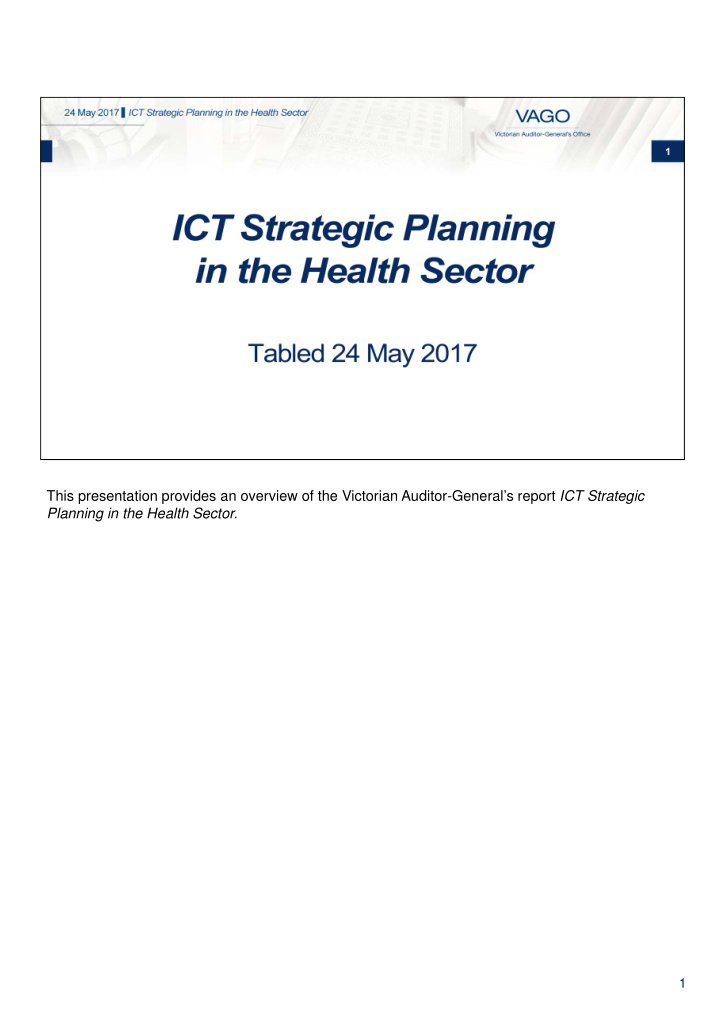



This presentation provides an overview of the Victorian Auditor-General’s report ICT Strategic Planning in the Health Sector. 1
Strategic health information and communications technology (ICT) planning in the health sector is essential for the delivery of efficient and high-quality care to Victorians. It will also assure that scarce funding is appropriately allocated. With 86 public health services, Victoria needs a coordinated and integrated health ICT approach. 2
Victorian public health services are responsible for defining and implementing their own health ICT strategy. The Department of Health and Human Services (the department) is responsible for ensuring that health services’ ICT strategic plans are in line with the department’s ICT strategy for the sector. 3
The public sector does not have a good track record with ICT initiatives. The 2003 Health SMART program aimed to introduce mandated clinical ICT applications throughout the public health sector, but was discontinued in 2012. By this time all of its allocated funding had been spent, and it had been rolled out to only four of the planned 19 health services. 4
In 2013, our audit report Clinical ICT Systems in the Victorian Public Health Sector noted that Health SMART failed because of poor planning and inadequate understanding of the complex requirements for designing and implementing clinical ICT systems. Our report and the 2013 Ministerial Review of Victorian Health Sector Information and Communication Technology highlighted the absence of a statewide health ICT plan, and recommended that one be developed. 5
In October 2014, the Statewide Health ICT Strategic Framework (the Framework) was released to help health services prepare local ICT strategic plans and align key outcome s throughout the sector. In November 2016, the Minister for Health approved a new Digitising Health strategy , which emphasises the critical role of digital technologies in improving how healthcare is delivered. 6
We looked at whether the Framework is consistent with the broader strategic objectives of the government’s ICT strategy, Information Technology Strategy: Victorian Government 2016–2020 and whether the department is appropriately implementing the Framework. We looked at whether the department is providing clear leadership to inform ICT strategic planning by health services. We also examined whether ICT strategic planning at the health services level is effective by focusing on four selected health services—Ballarat Health Services (BHS), Eastern Health (EH), Northern Health (NH) and Melbourne Health (MH). 7
Further work is required from the department to fully and effectively implement the statewide Health ICT Strategic Framework, with four of its 16 actions requiring further work. It has not properly monitored its implementation by a governance body. and no evaluation framework is in place to assess the effectiveness of the Framework and the completed actions. The department’s investment decisions have not been informed by a comprehensive understanding of clinical ICT maturity or an inventory of key ICT assets in the sector. As a result, there is limited assurance that scarce government funding has been directed to address the most critical health ICT needs or has been appropriately distributed. However, the department has been improving its leadership and support to public health services, and it is committed to better engagement with the public health sector, and planning more effectively for integrated clinical ICT systems. 8
Both BHS and EH have effective health ICT strategic planning processes. In contrast, MH and NH need to improve aspects of their planning processes, although MH had most aspects in place and NH is preparing a new strategic plan. In the past, the department had provided little support to MH, NH and BHS when planning for their health ICT systems. These three health services have received more support since the department appointed a Health Chief Information Officer in late 2015. This should help ensure better alignment between local ICT investments and statewide health ICT strategic direction. 9
We made 13 recommendations to the department, focusing on developing evaluation frameworks, improving risk-assessment practices, assessing ICT capability and maturity at the health services, conducting a comprehensive inventory of ICT hardware and software in the sector, improving processes for allocating funding and associated assessment and reporting requirements, and improving knowledge sharing in the sector. We made one recommendation to MH, two recommendations to NH and one to all four health services that they review their ICT strategic plans to ensure they are in line with the Digitising Health strategy. All of our recommendations were accepted. We also recommend that other public health services consider whether these recommendations apply to them and take appropriate action. 10
For further information, please see the full report of this audit on our website, www.audit.vic.gov.au. 11
Recommend
More recommend